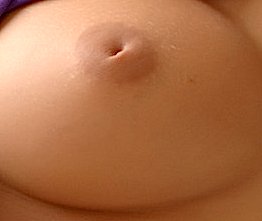|
Flat nipples are fairly common while truly inverted nipples are rare. Most types will not cause a problem during breastfeeding and if they do, there are ways to overcome them and succeed at breastfeeding. Babies feed from the breast not from the nipples – hence the term BREAST-feeding and not nipple-feeding. A breastfeeding baby draws the nipple far back into his mouth in order to suck effectively. Sometimes flat or inverted nipples can cause baby to have difficulty drawing the nipple deep into his mouth. 
There are several levels of inversion; minor, moderate and severe, which would describe a nipple that retracts greatly to a alongside or even below the areola. Some women have one average nipple and one that is flat, inverted, or dimpled. Many women have tried nipple therapy and treatment and have found it helpful for that reason breastfeeding specialists continue recommending a selection of treatment methods regardless of the debate over whether or not it makes a difference. There is still discussion over what stage it should be done. Most experts do not recommend treatment during pregnancy given that pregnancy hormones may help the nipples to protrude before the baby is born. Only when a baby arrives, and is having difficulty latching on, will it be known whether or not treatment is necessary. The optimal cure for flat or inverted nipples is a healthy and hungry newborn baby latching on and feeding. Most babies who latch-on well can draw out an inverted or flat nipple. Remember that breasts that are full with milk or engorged are much harder to latch onto so the early days before your milk comes in are the best days to learn together with your baby. The TestYou can find out if you have flat or inverted nipples by gently compressing the areola, about an inch behind the nipple, between thumb and forefinger. Generally nipples will protrude. Flat nipples do not react to this test and will not protrude or become erect even when stimulated or cold. Inverted nipples cave inwards and retract into the skin. Your nipples will not need any special care to enable breastfeeding if they protrude in the test or when cold or stimulated. Dimpled nippleThe dimpled nipple involves only a part of the nipple. This type does not protrude when stimulated but can be pulled out with your fingers and does not stay out when you release it. Nipple therapyGood latch. The first step to successful breastfeeding in any case is a good, proper latch between your breast and your baby.Shape your nipple. Hold your breast behind the areola, with your fingers underneath and thumb on top – your hand forming the letter, “C”. Press in with your “letter C hold” and push back toward your chest at the same time. This extends and tapers the areola, allowing your baby to latch on with less effort. This is known as a “breast sandwich" or “nipple sandwich” commonly used to get more breast tissue into a baby’s mouth. Breast pump. The use of a breast pump or other suction device immediately before a feeding may help to draw out inverted nipples. A high-quality, hospital grade, electric pump is the best choice for this purpose. Nipple enhancer device. There are special devices specifically designed to draw out inverted nipples before feeding such as, The Evert-it Nipple Enhancer. Home made nipple protractor. Ask a lactation consultant to assist you at making a nipple enhancer out of a 10 cc disposable syringe. Detach the plunger, and remove half an inch from the nozzle end. Place the plunger in the end of the syringe that you cut off. Rest the uncut end of the syringe on top of your nipple up against your areola. Pull on the plunger gently to protract your nipple just before nursing your baby. Breast shells These breast cups, or breast shields apply gentle constant pressure to the areola in order to try and break any adhesions under the skin that are preventing the nipple from being drawn out. The shells are worn inside the bra and have a part with a hole where the nipple goes through and a rounded cup that fits against your bra. The small hole is used for this purpose while the larger hole is intended for use with sore nipples. You can try wearing them between feedings or for a half an hour before feeding. Breast shells need to be washed with soap and hot water between feedings. They should not be worn at night and any milk that collects in them while being worn should not be given to your baby. Hoffman Technique. The Hoffman technique is a nipple stretching exercise that may help loosen the adhesions at the base of the nipple when performed several times a day. Use your 2 thumbs placed on either side of the nipple base. Push in firmly against your breast tissue and pull your thumbs away from each other at the same time. Nipple shield. A nipple shield is a flexible nipple made out of silicone that sometimes resembles a nipple used in bottle-feeding. There are different opinions on whether or not these should be used. Many breastfeeding mothers have resorted to using them and have had an easier time nursing their babies. If you decide that using a nipple shield is the best option for you and your baby please make sure that you use the right size and shape. Shields made from the thinnest material are best. Consult with an expert on how to use them to avoid future complications. It's important to know that if nipple shields are not used properly, it may cause further problems such as decreased milk supply or inadequate milk intake by the baby.
Inverted nipples and preparing for breastfeeding.
|